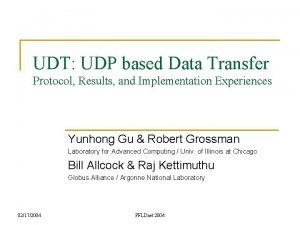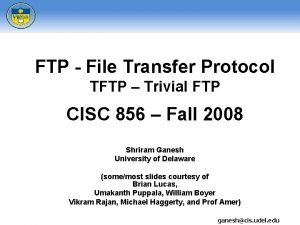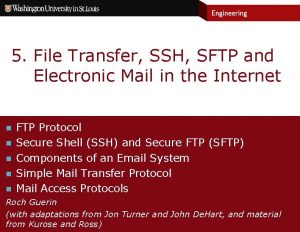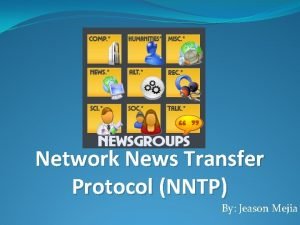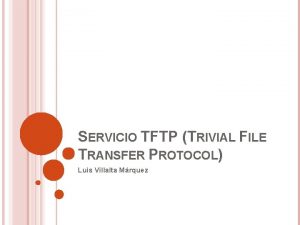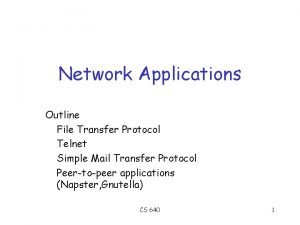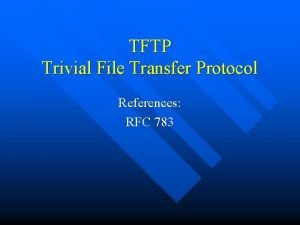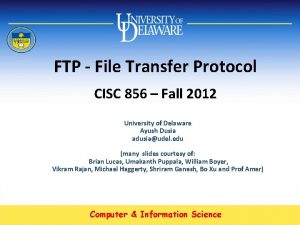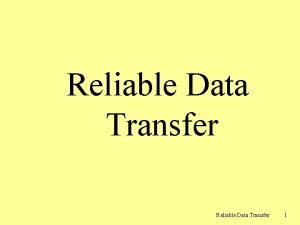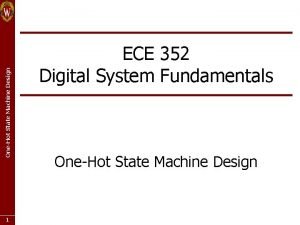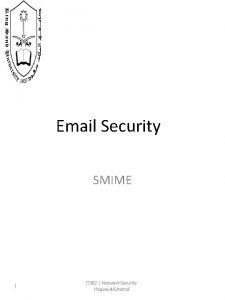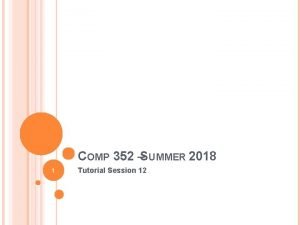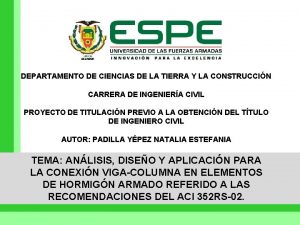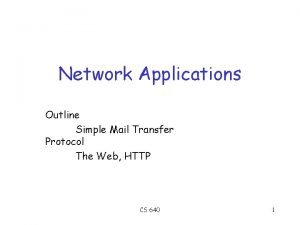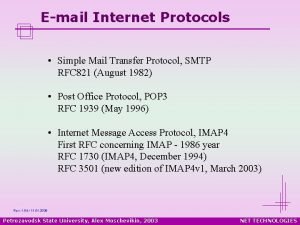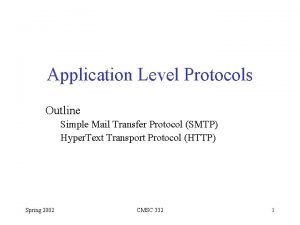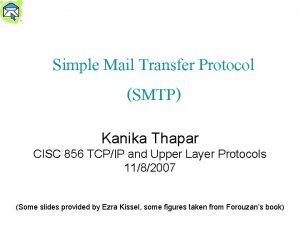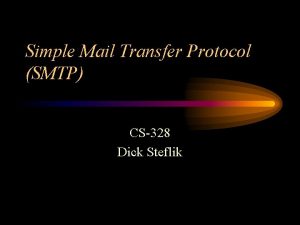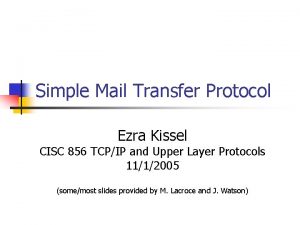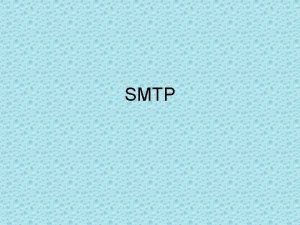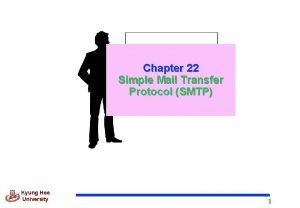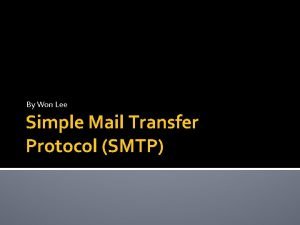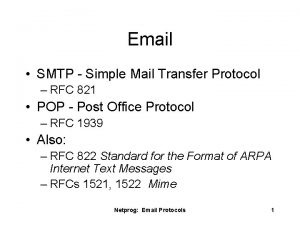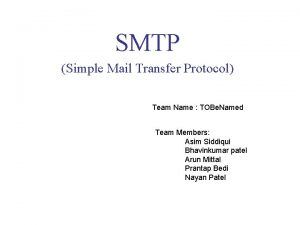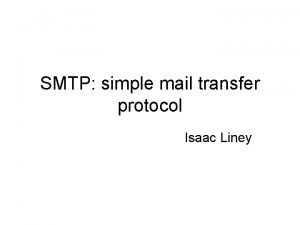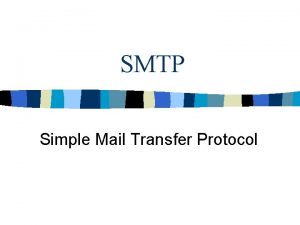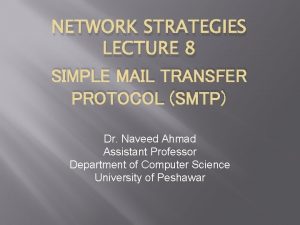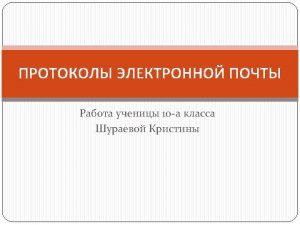CS 352 Simple Mail Transfer Protocol CS 352


















- Slides: 18

CS 352 Simple Mail Transfer Protocol CS 352, Lecture 5. 1 http: //www. cs. rutgers. edu/~sn 624/352 Srinivas Narayana 1

We’re all familiar with email. How does it work?

outgoing message queue Electronic Mail user mailbox user agent Three major components: 1. User agents • a. k. a. “mail reader” • e. g. , Applemail, Outlook • Web-based user agents (ex: gmail) mail server user agent SMTP mail server user agent 3

Electronic Mail: Mail servers 2. Mail Servers • Mailbox contains incoming messages for user • Message queue of outgoing (to be sent) mail messages • Sender mail server makes connection to Receiver mail server • IP address, port 25 3. SMTP protocol • Used to send messages • Client: sending user agent or sending mail server • server: receiving mail server user agent SMTP mail server user agent 4

Scenario: Alice sends message to Bob 4) SMTP client sends Alice’s message over the TCP connection 5) Bob’s mail server places the message in Bob’s incoming mailbox 6) Sometime later, Bob invokes his user agent to read message 1) Alice (alice@rutgers. edu) uses UA to compose message to bob@nyu. edu 2) Alice’s UA sends message to her mail server; message placed in outgoing message queue 3) Client side of SMTP opens TCP connection with Bob’s mail server 1 Alice user agent 2 mail server 3 Rutgers mail server 4 5 6 NYU mail server user agent Bob 5

Observations on these exchanges • Mail servers are useful “always on” endpoints • Receiving the email on behalf of Bob, should Bob’s machine be turned off • Retrying the delivery of the email to Bob on behalf of Alice, should Bob’s mail server be unavailable in the first attempt • The same machine can act as client and server based on context • Rutgers’s mail server is the server when Alice sends the mail • It is the client when it sends mail to Bob’s mail server • SMTP is push-heavy: info is pushed from client to server • Contrast to HTTP or DNS where info is pulled from the server

Sample SMTP interaction • A small demo

Sample SMTP interaction 220 hill. com SMTP service ready HELO town. com 250 hill. com Hello town. com, pleased to meet you MAIL FROM: <jack@town. com> 250 <jack@town. com>… Sender ok RCPT TO: <jill@hill. com> 250 <jill@hill. com>… Recipient ok DATA 354 Enter mail, end with “. ” on a line by itself Jill, I’m not feeling up to hiking today. Will you please fetch me a pail of water? . 250 message accepted QUIT 221 hill. com closing connection 8

MAIL command response codes 220: Service ready 250: Request command complete 354: Start mail input 421: Service not available 9

Mail message (stored on server) format SMTP: protocol for exchanging email msgs RFC 822: standard for text message format: header blank line • header lines, e. g. , • To: • From: • Subject: different from SMTP commands! (these would still be under “DATA”) body • body • the “message”, ASCII characters only 10

Message format: multimedia extensions • MIME: multimedia mail extension, RFC 2045, 2056 • additional lines in msg header declare MIME content type MIME version method used to encode data multimedia data type, subtype, parameter declaration encoded data From: alice@crepes. fr To: bob@hamburger. edu Subject: Picture of yummy crepe. MIME-Version: 1. 0 Content-Transfer-Encoding: base 64 Content-Type: image/jpeg base 64 encoded data. . . . . base 64 encoded data 11

CS 352 Mail: Access Protocols CS 352, Lecture 5. 2 http: //www. cs. rutgers. edu/~sn 624/352 Srinivas Narayana 12

Mail access protocols SMTP Alice SMTP user agent sender’s mail server POP 3 or IMAP 4 access user protocol agent Bob receiver’s mail server • SMTP: delivery/storage to receiver’s server • Mail access protocol: retrieval from server • POP: Post Office Protocol [RFC 1939] • Client connects to POP 3 server on TCP port 110 • IMAP: Internet Mail Access Protocol [RFC 1730] • Client connects to TCP port 143 • HTTP: gmail, outlook, etc. 13

POP vs IMAP • POP 3 • Stateless server • UA-heavy processing • UA retrieves email from server, then typically deleted from server • Latest changes are at the UA • Simple protocol (list, retr, del within a POP session) • IMAP 4 • Stateful server • UA and server processing • Server sees folders, etc. which are visible to UAs • Changes visible at the server • Complex protocol 14

What about web-based email? • Connect to mail servers via web browser • Ex: gmail, outlook, etc. • Browsers speak HTTP • Email servers speak SMTP • Need a bridge to retrieve email using HTTP 15

Web based email HTTP server SMTP Client SMTP server Internet 16

Comparing SMTP with HTTP • HTTP: pull • SMTP: push • both have ASCII command/response interaction, status codes • HTTP: each object encapsulated in its own response msg • SMTP: multiple objects sent in multipart msg • HTTP: can put non-ASCII data directly in response • SMTP: need ASCII-based encoding 17

More themes from app-layer protocols • Separation of concerns. Examples: • Content rendering for users (browser, UA) separate from protocol operations (mail server) • Reliable mail sending and receiving: mail UA doesn’t need to be “always on” to send or receive email reliably • In-band vs. out-of-band control: • In-band: headers determine the actions of all the parties of the protocol • There are protocols with out-of-band control, e. g. , FTP • Keep it simple until you really need complexity • • • ASCII-based design; stateless servers. Then introduce: Cookies for HTTP state IMAP for email organization Security extensions (e. g. , TLS) Different methods to set up and use underlying connections (e. g. , persistence) 18
 Parallelism examples
Parallelism examples Priority mail vs priority mail express
Priority mail vs priority mail express Google docshttps://mail.google.com/mail/u/0/#inbox
Google docshttps://mail.google.com/mail/u/0/#inbox Mail and telegraphic transfer
Mail and telegraphic transfer Udp-based data transfer protocol
Udp-based data transfer protocol File transfer protocol purpose
File transfer protocol purpose Sftp rfc
Sftp rfc Usenet message vanessa
Usenet message vanessa Trivial ftp
Trivial ftp Telnet file transfer
Telnet file transfer Trivial flag transfer protocol
Trivial flag transfer protocol Purpose of ftp protocol
Purpose of ftp protocol Reliable data transfer protocol
Reliable data transfer protocol A wave is a disturbance that transfers energy
A wave is a disturbance that transfers energy Ece 352
Ece 352 It 352
It 352 352 formação
352 formação Comp 352
Comp 352 Aci 352
Aci 352




